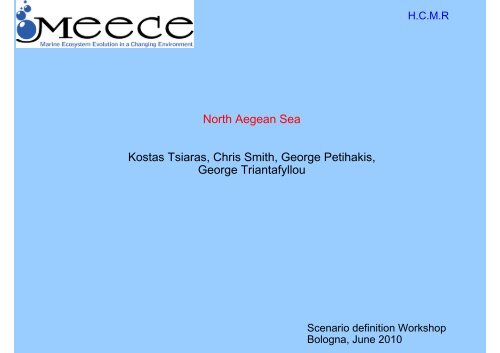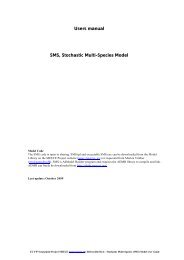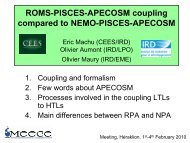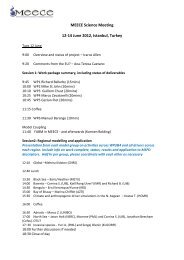North Aegean Sea Kostas Tsiaras, Chris Smith, George ... - meece
North Aegean Sea Kostas Tsiaras, Chris Smith, George ... - meece
North Aegean Sea Kostas Tsiaras, Chris Smith, George ... - meece
You also want an ePaper? Increase the reach of your titles
YUMPU automatically turns print PDFs into web optimized ePapers that Google loves.
<strong>North</strong> <strong>Aegean</strong> <strong>Sea</strong><br />
<strong>Kostas</strong> <strong>Tsiaras</strong>, <strong>Chris</strong> <strong>Smith</strong>, <strong>George</strong> Petihakis,<br />
<strong>George</strong> Triantafyllou<br />
H.C.M.R<br />
Scenario definition Workshop<br />
Bologna, June 2010
N. <strong>Aegean</strong> Coupled model<br />
Hydrodynamic model: POM (Blumberg and Mellor, 1983)<br />
Biogeochemical model: ERSEM-II (Baretta et al., 1995)<br />
POC<br />
DOC<br />
N, P, Si<br />
PicoPhyto Flagellates<br />
NanoPhyto Diatoms<br />
Bacteria<br />
Heterotr.<br />
Flagellates<br />
Microzoo<br />
Pelagic Model<br />
Mesozoo<br />
Si<br />
CO 2<br />
NO 3<br />
PO 4 NH4<br />
Sedimentation<br />
Benthic Model
Hindcast simulation 1985-2007 (spin-up 1980-1985)<br />
Atm. Forcing: 1980-2001 ERA40 Downscaled (0.5 o x 0.5 o ), Hermann and Somot, 2008<br />
2000-2008 HCMR POSEIDON operational (6-hour, 1/10)<br />
Rivers: Q, NO3, PO4 from SESAME, Ludwig et al. 2009, Dumont et al., 2005<br />
Initial Condition: NO3, PO4 from Medatlas 2002 climatology +spin-up<br />
Open sea productivity<br />
~ vertical mixing variability<br />
+ net nutrient flux across boundary<br />
-Dense water formation events (EMT)<br />
-SST increase around 1998 (~0.7 o C)
Climatic time-slice simulations 1990-2000 & 2090-2100 (A1B)<br />
to be extended to 20 years (1980-2000 & 2080-2100)<br />
Atm. Forcing: INGV-SXG (A1B, 1.2 o x 1.2 o ), Scoccimarro, 2007<br />
to be compared with IPSL forcing<br />
Rivers: Q, NO3, PO4 from SESAME (A1B scenario),<br />
Ludwig et al. 2009, Dumont et al., 2005<br />
Initial Condition: from hindcast simulation<br />
Increase in SST (~1 o C) +similar SSS<br />
increased stratification<br />
decrease in River discharge (~46%)<br />
+increase in nutrients concentrations -><br />
~similar nutrient river load (~8% decrease)<br />
weak productivity decrease in<br />
open sea (1%) and<br />
river influenced areas (3%)
Implementation of Acidification module<br />
-Setup of Mediterranean carbonate system model and preliminary simulations<br />
-Validation against DYFAMED and SESAME data<br />
-further calibration/validation in progress<br />
DYFAMED data SESAME data<br />
Begovic et al., 2002<br />
Krasakopoulou et al., submitted
Biomass (tonnes)<br />
ERSEM-POM coupling with OSMOSE<br />
Coupling Setup done<br />
Mapping of the area,<br />
Link of LTL model (ERSEM) with OSMOSE (7 phyto-zooplankton groups)<br />
Test case with 3 key species (anchovy, sardine, Scomber japonicus)<br />
140000<br />
120000<br />
100000<br />
80000<br />
60000<br />
40000<br />
20000<br />
0<br />
1 3 5 7 9 11<br />
Year<br />
13 15 17 19<br />
Anchovy<br />
Sardine<br />
In progress<br />
-setup of genetic algorithm to calibrate OSMOSE<br />
-finalize parameter set for all N. <strong>Aegean</strong> species<br />
Chub Mackeler Species Landings (Kg) % A<br />
Engraulis engrasicolus 23,502,489 43.7<br />
Sardina pilchardus 13,221,956 24.6<br />
Merluccius merluccius 4,406,099 8.2<br />
Boops boops 2,708,538 5.0<br />
Scomber japonicus 2,706,409 5.0<br />
Trachurus sp. 1,548,909 2.9<br />
Spicara smaris 1,149,183 2.1<br />
Scomber scombrus 1,137,496 2.1<br />
Sarda sarda 999,290 1.9<br />
Total 53,734,618
Fisheries<br />
Coupled ERSEM-OSMOSE model - possible fishing scenarios:<br />
1) Equilibrium (no change, constant harvesting of species)<br />
2) Different changes in effort (Fishing days, No. of boats)<br />
3) Change in closed fishing areas (geographical or depth related)<br />
4) Change in closed fishing seasons (Purse seines, trawlers)<br />
5) Fisheries pressure on specified species<br />
Species Fishing Gear Open <strong>Sea</strong>son<br />
Engraulis engrasicolus Purse seine 1 Mar - 15 Dec<br />
Sardina pilchardus Purse seine 1 Mar - 15 Dec<br />
Merluccius merluccius Trawl 1 Oct - 30 May<br />
Boops boops Purse seine, Trawl 1 Mar - 15 Dec / 1 Oct - 30 May<br />
Scomber japonicus Purse seine 1 Mar - 15 Dec<br />
Trachurus trachurus<br />
Trachurus mediterraneus<br />
Spicara smaris<br />
Scomber scombrus<br />
Sarda Sarda
Eutrophication/Land-based inputs – Thermaikos gulf<br />
Possible scenarios<br />
different water discharge (Climatic change)<br />
different nutrient loads and N/P from Axios river based on EUROCAT project<br />
(simulated by MONERIS catchment model under different assumptions regarding policies, agriculture<br />
development etc)<br />
• Fertiliser plants<br />
• P-free detergents<br />
• Urban waste<br />
• 1. BAU<br />
Nikolaidis et al., 2009<br />
2. Policy Target<br />
3. Deep green
Eutrophication/Atm-Deposition - <strong>Aegean</strong><br />
Atmospheric deposition plays a significant role in the oligotrophic <strong>Aegean</strong> <strong>Sea</strong> as is one of<br />
the main routes of nutrients into the marine environment<br />
Possible scenarios<br />
different atmospheric deposition (Climatic change of rainfall ±10%)<br />
different nutrient load composition in the deposition<br />
Land-based inputs/Acidification<br />
different Alkalinity input (provided by WP1?)<br />
Organic pollutants (Thermaikos)<br />
Possible scenarios<br />
different loads (Marco?)
Session 3. GES indicators for the N. <strong>Aegean</strong><br />
Descriptor 3: Populations of all commercially exploited fish and shellfish are within<br />
safe biological limits, exhibiting a population age and size distribution<br />
that is indicative of a healthy stock.<br />
Level of pressure of the fishing activity<br />
Descriptor 4: All elements of the marine food webs<br />
Productivity (production per unit biomass) of key species or trophic groups<br />
Abundance /distribution of key trophic groups/species<br />
Descriptor 5: Human induced eutrophication<br />
Nutrient levels<br />
Direct effects of nutrient enrichment<br />
Descriptor 8: Concentration of contaminants are at levels not giving rise to pollution<br />
effects<br />
Effects of contaminants
Session 4. Scenarios<br />
Fisheries<br />
Coupled ERSEM-OSMOSE scenarios:<br />
Equilibrium (no change, constant harvesting of species)<br />
Different changes in effort (Fishing days, No. of boats)<br />
Change in closed fishing areas (geographical or depth related)<br />
Change in closed fishing seasons (Purse seines, trawlers)<br />
Eutrophication/Land-based inputs/Atm-Deposition<br />
Thermaikos riverine inputs - variation in discharge and nutrient load<br />
N. <strong>Aegean</strong> atmospheric inputs - variation in inputs and quality (?)<br />
Pollution<br />
Thermaikos riverine inputs – variation in organic pollutants load








